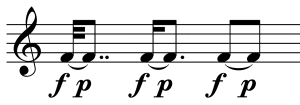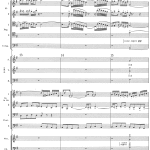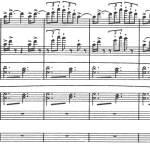Articulation and attack, the phonetics of music, is an area frequently shrouded in controversy, discussion and disagreement.
Depending on the instrument, playing style and traditions, the term tenuto or “sustained” – indicated by a dash above or below the note – supposedly means that the note must be sustained for the full duration of its value, that it must be slightly longer than that, or slightly shorter than notated! It is hardly surprising that this can cause confusion and disagreement. Staccato – indicated by a dot – is equally ambiguous. Is an eighth note marked staccato shorter than a quarter note marked staccato, and is this quarter note shorter than a half note marked with a dot? A general consensus simply does not exist.
And how does one interpret a symbol combining tenuto and staccato, i.e. two symbols, each with an ambiguous meaning in itself?[1]
Just as troublesome – or even worse – are instructions such as “Viennese sforzato,” “Paris accent,” “opera forte-piano,” etc. Their meaning may be well known and crystal clear to some, but vague or unfamiliar to others.
Considerable differences exist in how certain articulation symbols are interpreted within each instrument type. Consecutive notes marked tenuto will be executed differently by a violin player, a clarinet player or a tuba player: hardly any rest between the notes on a violin, a noticeable rest on a clarinet (because a woodwind player will block the stream of air with the tongue) and a pronounced rest between notes on the tuba (where it is often played almost like fp). Similar differences exist in the execution of legato and non-legato. For a string player, a legato slur always indicates that the notes should be played in a single bow, if at all possible; for a wind player it means that the stream of air should only be interrupted if a breath is necessary. If no legato is indicated, a string player will execute consecutive notes by changing bow direction on each note, but playing quasi legato (paradoxically, the technical term is detaché), whereas a wind player will always tongue each note when playing a passage without legato marking, resulting in a noticeable separation between individual notes.
In the study of human languages, phonetics is an area with fairly precise terminology, definitions and symbols (think, for example, of phonetic notation). Therefore it is highly regrettable (and somewhat surprising) that music theory, a largely comparable field, to this day is fraught with randomness, habits (usually tied to certain instruments or local traditions) and general confusion. Composers continue to have to explain how they wish certain symbols to be interpreted and executed. A major global symposium with the power to establish internationally binding rules is not to be expected. Therefore, the individual composer or orchestrator must aim at consistency in the use of articulation symbols, with sensitivity for the current state of consensus.
A comparison with the field of phonetics may shed light on the problem: the use of unambiguous symbols indicating a note to be articulated as zah, tah, pah, lah or the soft ∂ah would be a step in the right direction. And although some would argue that this corresponds to sfz, fp, accent, tenuto and “dal niente,” no agreement can be expected. In his path-breaking piano piece Mode de valeurs et d’intensités, Olivier Messiaen applied a predetermined serial scheme to no less than seven different piano attacks. But with respect to the precise execution of the articulation symbols he notates, Messiaen had to rely on a notational consensus that hardly existed.
To some extent the problem may be bypassed, for example by notating a shorter note value tied to a longer one and assigning different dynamics to the two notes, thereby clarifying how a particular articulation such as fp is intended to sound.
To increase the level of precision, this can be further refined, but the obvious risk is to overburden the musical text with information and thereby sacrifice readability.
As mentioned numerous times earlier, the orchestral medium provides unique possibilities to ensure precise, predetermined articulation. Below a series of examples showing how articulation can be created and refined far beyond the interpretation of symbols. This does not solve the problem of notation as such, but it shows a number of alternative solutions and certainly helps to illuminate not only an important aspect of the art of orchestration, but also the status of the orchestra as a precision instrument.
In the following two examples, flutes create a piano-like attack typical of Stravinsky.
Figure 143 · Stravinsky, Chorale Variations on “Vom Himmel hoch” (Bach), var. 4, m. 13
Figure 144 · Stravinsky, Petrushka, m. 1
And here a very effective accent on the note F#.
Figure 145 · Stravinsky, Petrushka, number 121, m. 2
This type of orchestrated articulation is an essential part of writing idiomatically for the orchestra, and the list of examples could be extended almost infinitely.
· · ·
Next · Chapter 12. Timbre, Sound Combinations and Imitation
· · ·
[1] As mentioned earlier, this symbol had a unique and precise meaning for Stravinsky: “pizzicato-like attack that rings on.” This was only possible because Stravinsky travelled the world conducting his own works and had the opportunity to explain how he wished the symbol to be interpreted.



